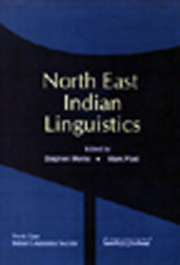Book contents
- Frontmatter
- Contents
- Introduction
- Foreword
- Phonology
- Lexicon
- 5 Lexicon in a Contact Language: The Case of Bishnupriya
- 6 Shafer's ‘parallels’ between Khasi and Sino-Tibetan
- 7 An Exploratory Study of the Terms of Relationship in Khamti of Lohit district in Arunachal Pradesh
- 8 Verbs of Position, Existence, Location and Possession and their Grammaticalization Pathways in the Tani Languages
- Morphology, Syntax, and Semantics
- Language Description and Language Endangerment
5 - Lexicon in a Contact Language: The Case of Bishnupriya
from Lexicon
Published online by Cambridge University Press: 26 October 2011
- Frontmatter
- Contents
- Introduction
- Foreword
- Phonology
- Lexicon
- 5 Lexicon in a Contact Language: The Case of Bishnupriya
- 6 Shafer's ‘parallels’ between Khasi and Sino-Tibetan
- 7 An Exploratory Study of the Terms of Relationship in Khamti of Lohit district in Arunachal Pradesh
- 8 Verbs of Position, Existence, Location and Possession and their Grammaticalization Pathways in the Tani Languages
- Morphology, Syntax, and Semantics
- Language Description and Language Endangerment
Summary
Introduction
This is an abridged version of the paper presented at the NEILS meeting held in 2006 in Guwahati. The paper basically puts forth the idea that lexicon, together with other information can be used as an archive to understand the linguistic and cultural past of a language. The idea, though in itself not new in historical and comparative linguistics, remains underutilized in studies of contact languages. In the case of contact language such as Bishnupriya, where much of its multi-linguistic past involving numerous spoken vernaculars is hardly documented, lexicon can be utilized to understand the profile of the contact itself and to provide pointers for further investigations. The present study constitutes an important attempt in this direction. In the first part, the paper provides a brief overview of the circumstances under which Bishnupriya developed. In the second part, we assess the role of two contributing language families in the formation of Bishnupriya by undertaking an investigation of the Bishnupriya lexicon itself. A quantitative approach is used to analyse the genetic composition of the Bishnupriya lexicon. Basic vocabulary (nouns only), less likely to be borrowed under casual contact, is analysed to understand further the specific spheres of contact and the nature of relationships that are likely to have existed between the linguistic and social groups involved in the contact. The discussion is further extended to the distribution of lexicon across various grammatical categories and across contributing language families. The study draws on our corpus of Bishnupriya, covering both diachronic and synchronic data.
- Type
- Chapter
- Information
- North East Indian Linguistics , pp. 75 - 92Publisher: Foundation BooksPrint publication year: 2008
- 2
- Cited by



